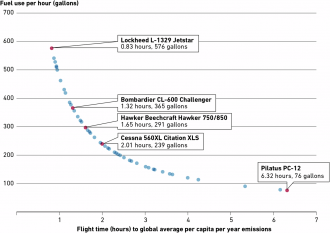Media release
From:
Climate change: Significant increase in carbon dioxide emissions from private aviation
Annual emissions of carbon dioxide (CO2) from private aviation increased by 46% between 2019 and 2023, according to an analysis published in Communications Earth & Environment. The results also show that some individuals who regularly use private aviation may produce almost 500 times more CO2 in a year than the average individual, and that there were significant emissions peaks around certain international events, including COP 28 and the 2022 FIFA World Cup.
Private aviation is highly energy-intensive, emitting significantly more CO2 per passenger than commercial flights, but is used by approximately 0.003% of the world’s population. However, the true scale of global private aviation, and the emissions it produces, is currently poorly understood.
Stefan Gössling and colleagues analysed the flight tracker data of 18,655,789 private flights flown by 25,993 registered business jet-type private aircraft between 2019 and 2023, which represent the vast majority of private aviation. They then calculated the CO2 emissions of each flight by combining the advertised fuel consumption rate of the aircraft’s model with flight duration and trajectory. The authors found that these flights cumulatively produced approximately 15.6 million tonnes of CO2 in direct emissions in 2023 — an average of approximately 3.6 tonnes of CO2 emissions per flight. This was a 46.0% increase in emissions from private aviation compared to 2019, and equivalent to approximately 1.8% of the total emissions produced by commercial aviation in 2023.
The authors note that major international events are associated with a particularly large volume of private flights. COP 28, for example, was associated with 644 private flights which produced 4,800 tonnes of CO2, whilst the 2022 FIFA World Cup was associated with 1,846 private flights which produced 14,700 tonnes of CO2. The authors also note that the highest emitting individuals produced 2,400 tonnes of CO2 each in 2023, based on the flight data of their planes’ unique tail numbers. This is almost 500 times more than the average amount of emissions produced per person in 2020 (4.5 tonnes of CO2 equivalent).
Together, these findings underscore the significant role of private aviation in emissions and climate change.
***
Springer Nature is committed to boosting the visibility of the UN Sustainable Development Goals and relevant information and evidence published in our journals and books. The research described in this press release pertains to SDG 11 (Sustainable Cities and Communities) and SDG 13 (Climate Action). More information can be found here.
Multimedia




 Australia; International
Australia; International



